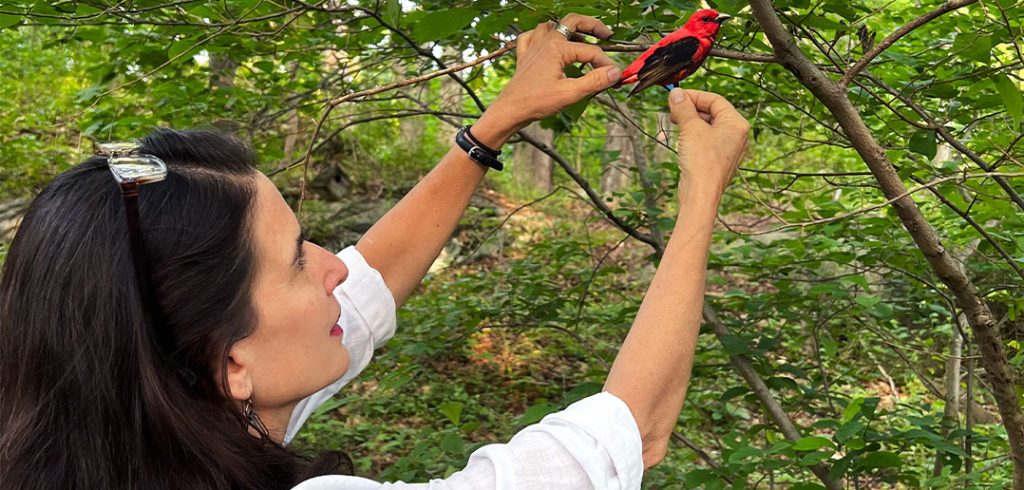With her latest project, conceptual artist and photographer Carolyn Monastra has been traveling to places where birds are in danger of habitat loss. She hopes to spur viewers to take action around climate change.
With a passing glance, the Canada jay overlooking Peyto Lake in the Rocky Mountains of Alberta, Canada, appears to be completely real—but if you hold your gaze, an unnatural outline becomes clearer, and you realize you’re looking at a facsimile. The photo below is part of a project called The Divergence of Birds, in which artist Carolyn Monastra, FCRH ’88, photographs paper cutouts of birds in their native habitats—a nod to a future in which the real birds may be forced out of those current homes.

Monastra said that the idea for the project came out of reading a 2014 National Audubon Society climate report that found that 314 North American bird species will lose more than half of their climatic range by 2080—a number that increased to 389 species in a 2019 report.
Monastra, who also teaches photography at Nassau Community College, plans to photograph cutouts of each of those 389 birds for the project. Where she cannot travel to the actual habitats to shoot photos, she said, she will recreate the environment, and she’ll gradually document all the photos on the project website, along with some behind-the-scenes photos and videos of her process.
“I want people to understand that they’re cutouts from the time they come to it,” she said, “using that as a way to get them to pay attention to the birds in my photographs, see what’s happening to them, and then go outside and get engaged.”



Committing to Photography and Finding Inspiration
In the 1980s, Monastra majored in English at Fordham College at Rose Hill, where she was a member of the honors program, but she also took several photography classes at the Lincoln Center campus. One of her photography professors, Joseph Lawton, saw her talent behind the camera and encouraged her to pursue an M.F.A. after she graduated in 1988.
After several postgraduation years serving in the Jesuit Volunteer Corps in Santa Monica, California, and exploring a career in social work, Monastra followed Lawton’s advice. She enrolled in the M.F.A. program in photography at Yale Universityto “finally commit to being a photographer,” she said.
Once she had her master’s, she began teaching, and she has held several high school and college jobs, including a year as a photography instructor at Fordham. She has been teaching full time at Nassau Community College since 2005, all the while pursuing her own projects outside the classroom, like lovely, dark and deep, in which she turned to “the fragmentary space of dreams and my experiences with the environment to discover and create mystery in the natural world,” and The Witness Tree, which immediately preceded The Divergence of Birds and also dealt with climate change, in that case through a series of landscape images showing the effects of climate disasters.
Monastra first saw the Audubon Climate Report while working on The Witness Tree, and the wheels for a bird-centered project began turning. She thought about her own history with the animals, and she began buying books for research—books that would ultimately provide a more material kind of inspiration.
“I was really interested in how birds build their nests,” she said. “I’d never really been a birder until I started this project, but my mom always had bird feeders, so we always had birds around. I was buying all these secondhand bird books to learn about birds building their nests, and then I just started cutting them out.”
She also was reading Philip K. Dick’s science fiction novel Do Androids Dream of Electric Sheep? around that time, and she said that the dystopian world of the book, in which electric versions of animals are so realistic that no one can tell the difference between them and the real thing, resonated with her.
“That little part also made me think about this idea of facsimile and simulacra, and how sometimes we’re fooled by that. And in a future warming world, if we don’t protect what we have, that’s all we’ll have left.”



An Artist’s Responsibility
In addition to updating the project website on a rolling basis, Monastra has been thinking about ways to bring the project to a wider audience in various settings. In October, she had a residency at NYC Audubon’s environmental center on Governors Island, where she used the images for banners she could string throughout the center.
And much like a Postcards to Politicians project she created for The Witness Tree, in which she encouraged people to handmake postcards from her collaged images and send them to politicians to push for climate action, she would like to engage communities with The Divergence of Birds directly.
“Adopt a Bird will be something similar, using recycled materials,” she said of her next planned public project. “I’ll have all the pictures of the birds in people’s area, wherever it happens to be. There will be a pledge they’ll make, as they adopt that bird, to promote climate change legislation.”
Beyond hands-on, collaborative art, she hopes that the photos will not only get viewers interested in birds but also spur them to take action around climate change in other ways. That is, she feels, one of her guiding forces as an artist.
“I think artists do have a responsibility to use their gift to talk about these issues,” she said. “Whether it’s climate change or social justice or anything else, I think we have the ability to translate numbers and statistics into something that can move people.”






